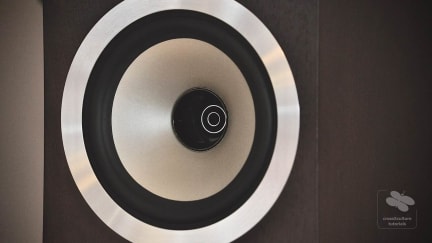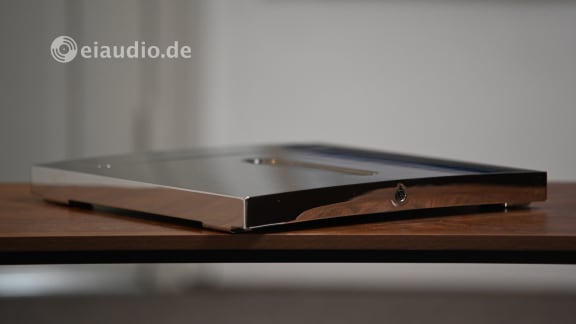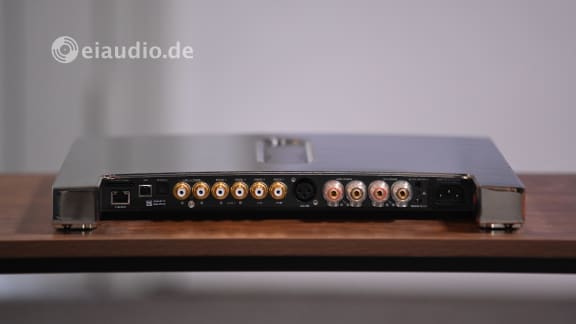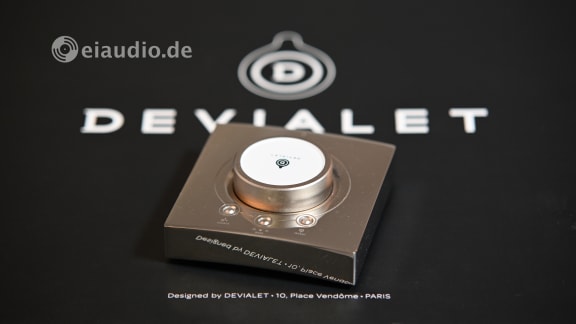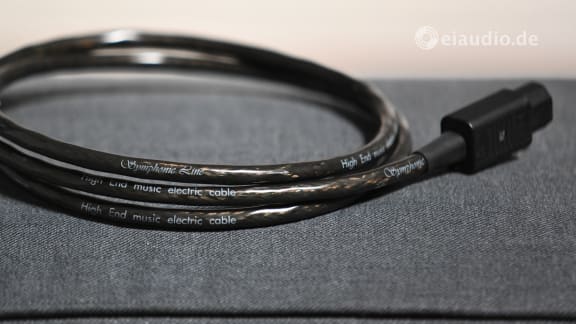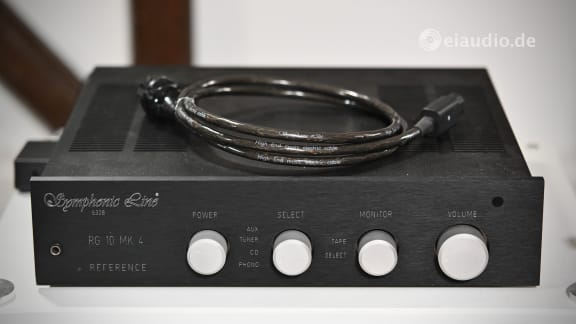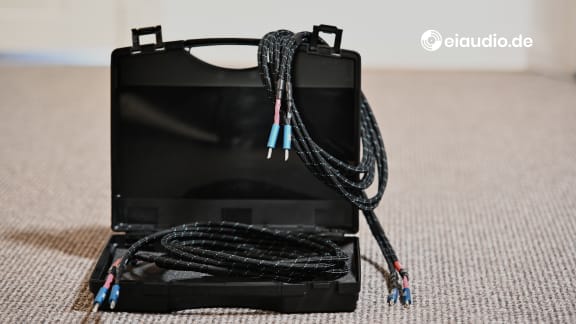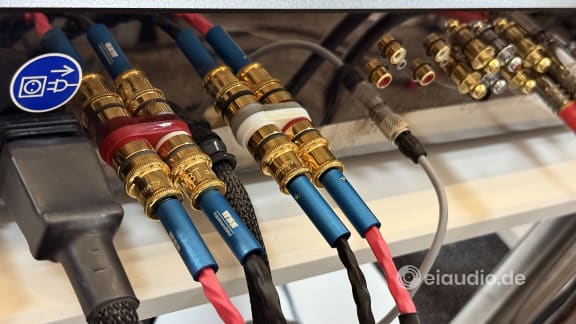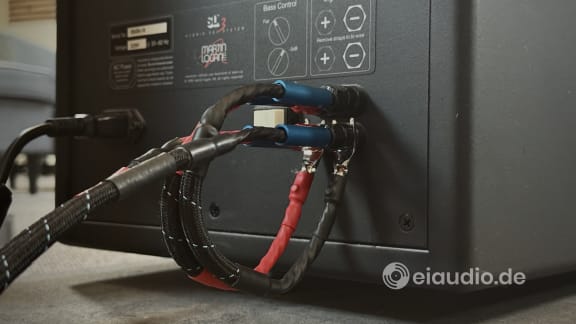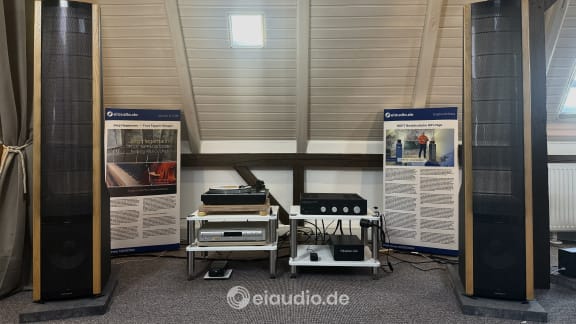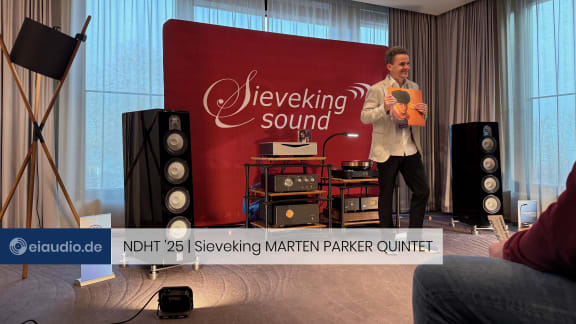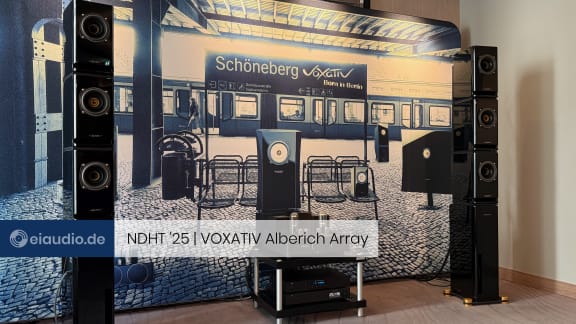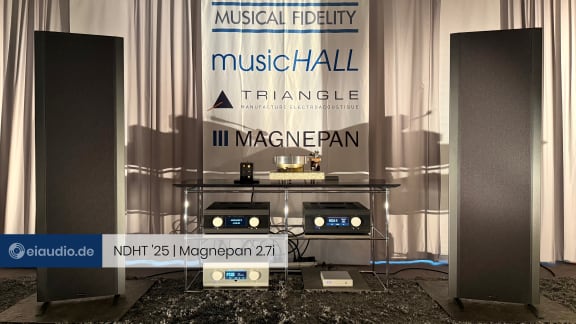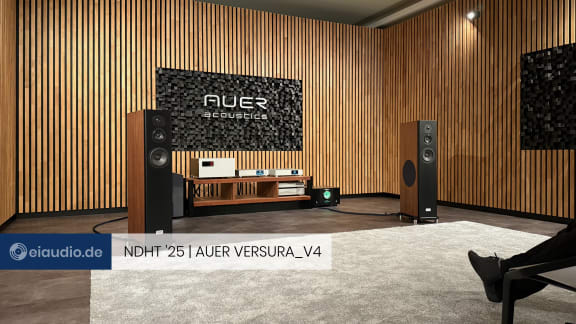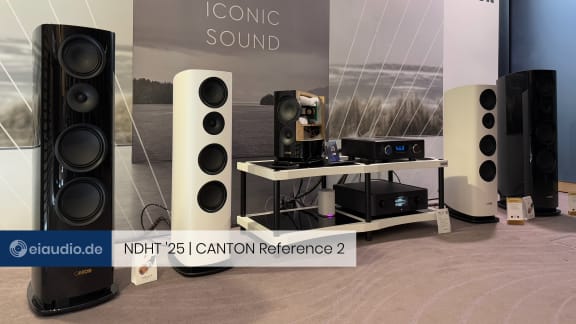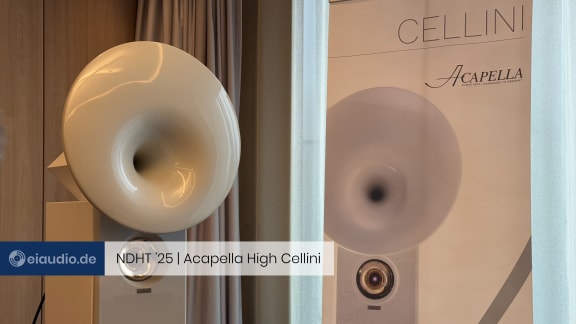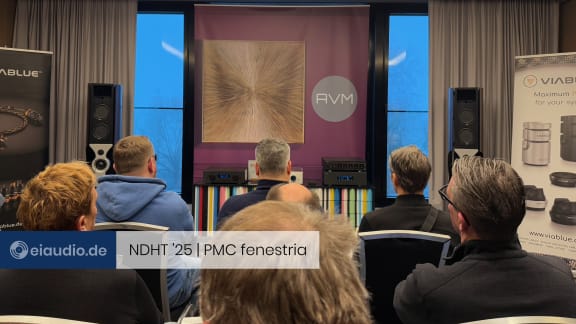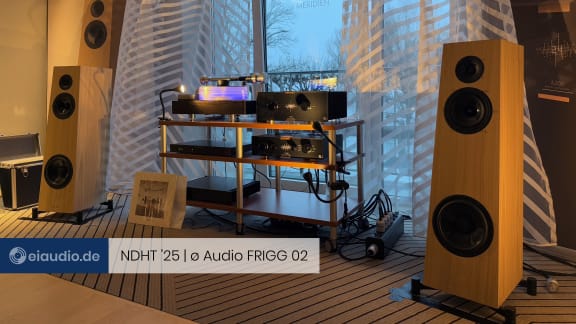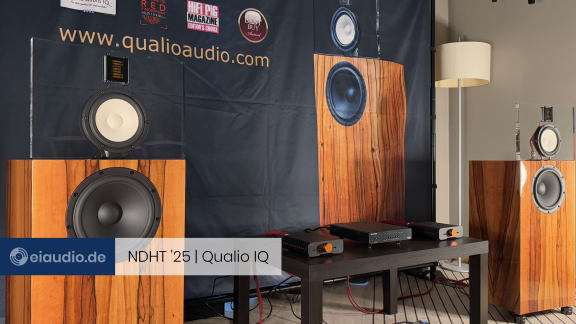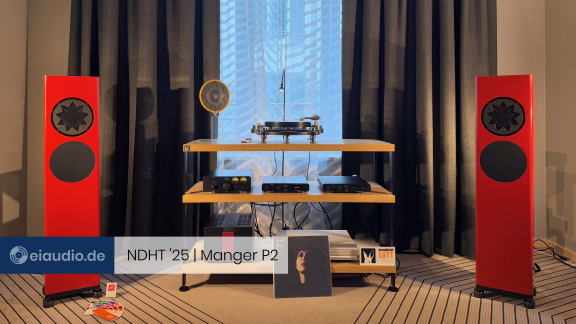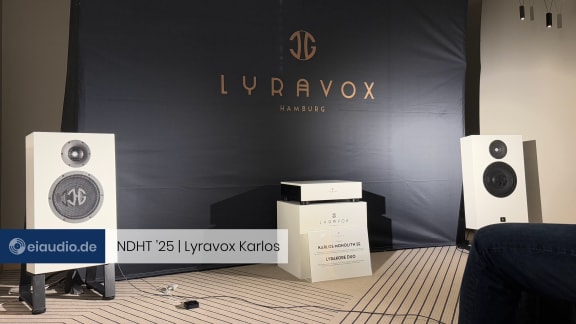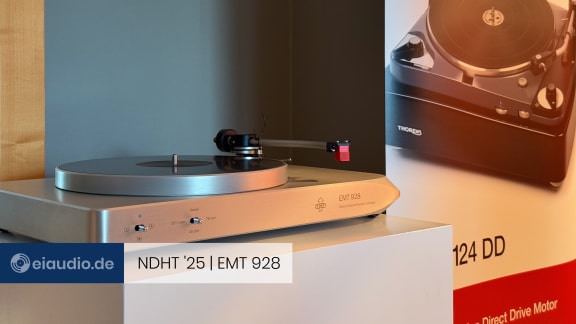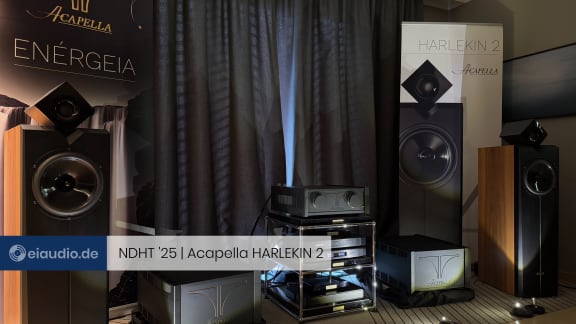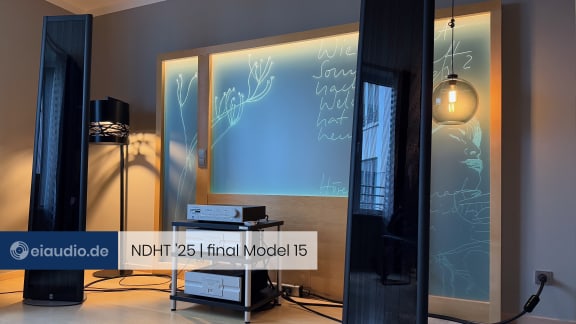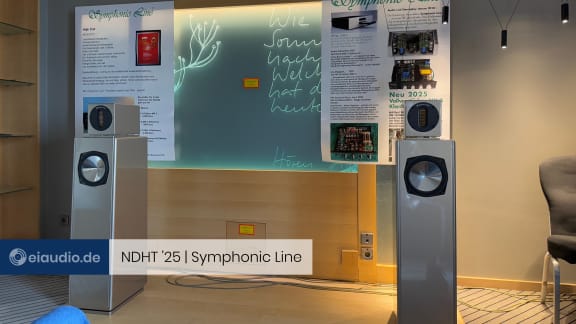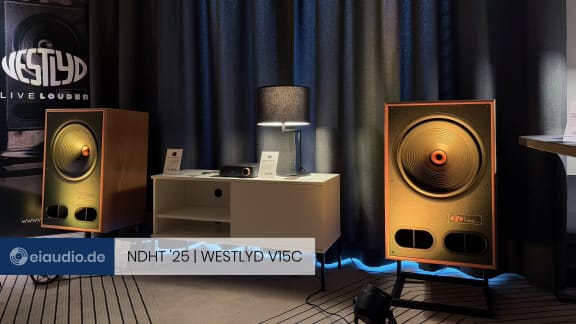Explorations in Audio
In 'Explorations in Audio' I aim to share some practical insights on setting up and optimising an affordable HiFi system. Although one would think that, really, all has been said about HiFi, some surprisingly simple questions still remain, e.g.: 'Is digital superior to analogue?' 'Do cables matter?' 'Can digital cables pick up interference?' 'Should speakers be placed on spikes?' 'Has evolution in HiFi made older gear obsolete?' 'Where should I place my sub?' 'Which room correction works best?' - On the other hand: 'Are these really the right questions?' - We shall see.
What's new in eiaudio?
While the entries in this blog are divided into the three distinct categories above, you will find a mixed listing of the most recent postings below. The most recent article is shown first. If this is not your first time visiting, the listing below is a good place to quickly check if anything is new.
Your input is more than welcome, as long as you follow the basic audiophile rule of ‘ear over mind’. This means that you do not comment based on what you think you know, but only on the basis of your own listening experience. Please feel free to suggest gear for testing as well as leave comments on the descriptions provided here.
eiaudio’s 5th Anniversary
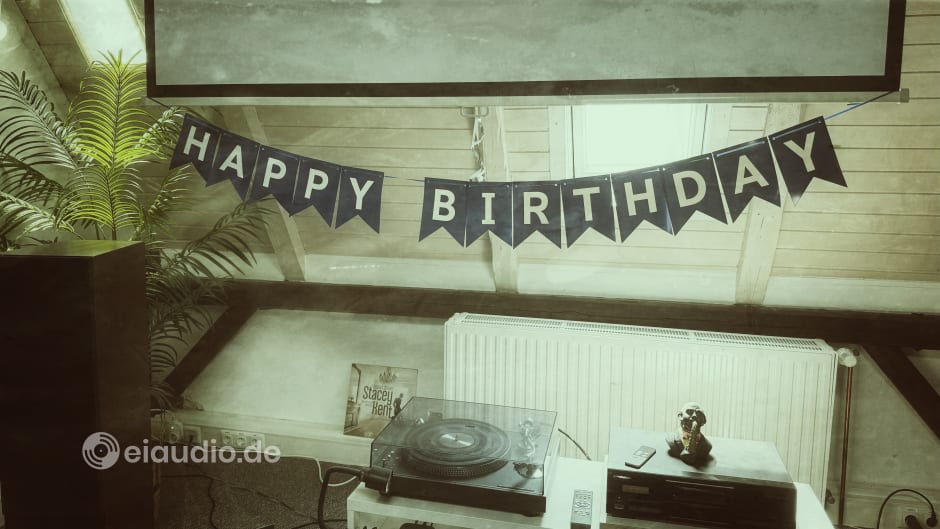
Published: 09/06/2025
Author: Karsten Hein
Category: Explorations
Tag(s): Contemporary
I am writing these lines in the week of eiaudio’s fifth anniversary and find that our world, technology, and future outlook have changed dramatically since then. Back in April 2020, citizens around the globe were experiencing government-imposed lock-downs that had been put in place to slow down the spread of the Covid-19 flu-pandemic. In order to stay in business during these restrictions, companies ended up moving vast portions of their communications and operations to cloud-based servers and online platforms, which culminated in the largest synchronous data upload in world history. With my family’s language school business closed down for several weeks and both our kids at home due to the restrictions, I wrote my first article on my smartphone. I wanted to tell the story of HiFi from the very beginning, and so I called the article: “The Power Source”.
My aim was to share what I had learned about HiFi setups and gear with like-minded enthusiasts. I wanted to document my discoveries for my own future reference in a place I could rely on, to encourage my readers to make new discoveries and trust their own ears, and also to set up an alternative platform to my family’s language school operations, which could apparently be shut down very quickly, as the German government had made clear to us. Built on a basis of truthful personal reflection, the blog was destined to become a beacon of audiophile integrity, limited only by the scope of my experience and understanding. Having such a strong basis in personal appreciation proved to be beneficial to the website’s reception, and eiaudio.de soon attracted well over 10,000 individuals each month who stuck around to read many more articles.
Today, my eiaudio blog is even more influential than shown in the numbers above. It helps people around the globe form their opinions on subjects such as HiFi setups, room acoustics, vintage gear, and listening skills. However, in many cases, the people benefiting from my articles do not really need to visit my page anymore. Instead, they ask an AI-bot like Chat GPT to collect the information for them. With most of human data and experience available online, it was only a matter of time, before someone came up with an algorithm that could drink from this extensive pool of human labour without its user having to visit the sources that feed into the pool each time. And there is more: AI bots cannot only extract information from the web but now also organise data in order to create spoken and written texts, images, and also music. The bottom line is that output once unique to us humans is henceforth subject to automation by bots, and those sharing their insights online, like myself, are feeding them for free.
As it looks now, our social stability and order, sense of purpose and justice, personal commitment and resilience, will all be tested at the same time, while AI is leading us towards completely uncharted territory at breakneck speed. Some industries will be affected by these changes sooner than others. The music industry, for instance, has already been forced to make the transformation from the High Fidelity-sound of the 1960s to 1990s (first based on vinyl and later on CD sales) via the iPod (with predominantly MP3 as its basis) to the High-Res streaming services of our time. In the face of local music abundance, due to instant worldwide availability, the formerly large budgets of music labels have shrunk dramatically and with them the incomes of the artists providing the music. With earnings from music sales at an all-time low, the price of concert tickets has skyrocketed. Those artists who do not manage to attract regular crowds mostly go empty handed.
In most modern households, High Fidelity has been reduced to the sound quality of smart speakers, and few people take the time to set up a proper HiFi system or to develop their listening skills anymore. Slowly, we are learning that information without structure and context is disinformation. Just like high-frequency noise clutters the iron core of a transformer and prevents it from working properly, the helpless attempt of today’s global brands of reaching all consumers directly via social platforms makes people withdraw from communication on many levels, unsure of what to believe anymore. There are simply too many companies and too many products for the consumer to process when these make a pitch all at once. The pendulum of globalisation has swung from the scarcity of goods and local production all the way to the abundance of goods with failing consumer demand and a general drifting towards the pointlessness of everything.
After all, what is the point of me writing reviews that are predominantly going to be read by bots and that are therefore no longer linked to my name? And what is the point of factories making products faster and faster in which the workforce has long since been replaced by robots and companies stalking communities online, trying in vain to sell products to people who have lost their jobs and no longer have the means to purchase anything? — One could argue that five years after Covid-19, the full scale of human greed and stupidity is more blatantly obvious than ever before. Although we are family and clan-based social beings and therefore utterly dependent on each other for survival, our current economic model mostly rewards those who most quickly come up with products and services that threaten and break apart the pillars of our social fabric and environment.
While eiaudio is about deep contemplation and making time for appreciation, the current trend of placing everything at our disposal at once, seemingly without the need for personal understanding and growth, is luring us down a dark alley, ill-prepared for what awaits us. I would have liked to see a deep connection to evolve between the readers of my blog (commenting section) and myself. This can still happen, of course. But with bot visits heavily on the rise, the risk of us never getting to know each other and drifting further apart as HiFi enthusiasts, families, and nations seems very real.
Best wishes,
Karsten

Devialet Expert 250
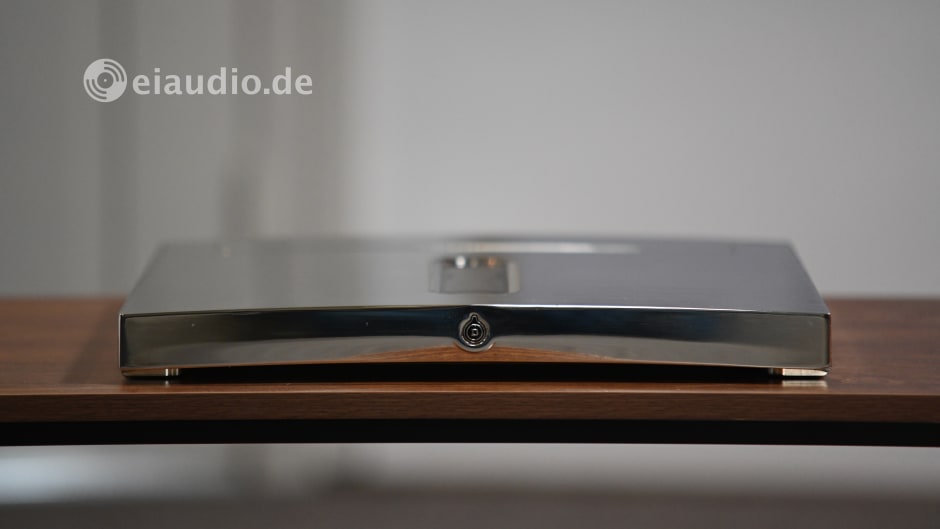
Published: 12/04/2025
Manufacturing date: 2013
Author: Karsten Hein
Category: Gear & Review
Tag(s): Integrated Amplifiers
[Listening test in progress. Full review coming up.]
Sleek, slim, and beautifully enigmatic. The Devialet Expert 250 combines its timeless design with plenty of 21st century features to facilitate multi-level integration in contemporary home entertainment systems. It clearly shows that versatility and High-End sound quality need not be mutually exclusive.
Specifications
- Type: Integrated hybrid class A/D amplifier
- Power output (RMS, 6 Ohms): 250 WPC (from v7.0)
- High-current stability: 2 Ohms
- Frequency spectrum: 0.1 Hz-87,000 Hz (-3 dB)
- Total harmonic distortion: 0.001% (at power max)
- Signal to Noise Ratio: > 130 dB
- Digital features: Built-in DAC, WiFi-streamer, DSP
- DSP specifications: 400MHz, four channel, 40-bit
- Analogue inputs (RCA/cinch): 24 bit / 192kHz (up-sampling)
- MM/MC phono stage: capacitance/resistance matching
- Line-level inputs: 2x customisable
- Digital inputs (S/PDIF RCA): 4 assignable slots (max.)
- Further inputs: Toslink, AES/EBU, optical/RS232, USB, RJ45
- Wireless connectivity: built-in Devialet “AIR” WiFi
- Speaker outputs (banana/spades): 2-channel
- Subwoofer output: via line/RCA
- Digital outputs: AES/EBU and RCA
- Wireless sampling rates: 16-bit, 24-bit, 32kHz - 96kHz
- Coaxial and optical S/PDIF: 16-bit, 24-bit, 32kHz - 96kHz
- USB: 16-bit, 24-bit, 32-bit, 32kHz – 192kHz
- Dimensions: (H)4.05 cm x (W)40 cm x (D)40 cm
- Weight: 7 kg
- Country of manufacture: France
- Year(s): 2013 (based on original D-Premier)
Symphonic Line High End music electric cable
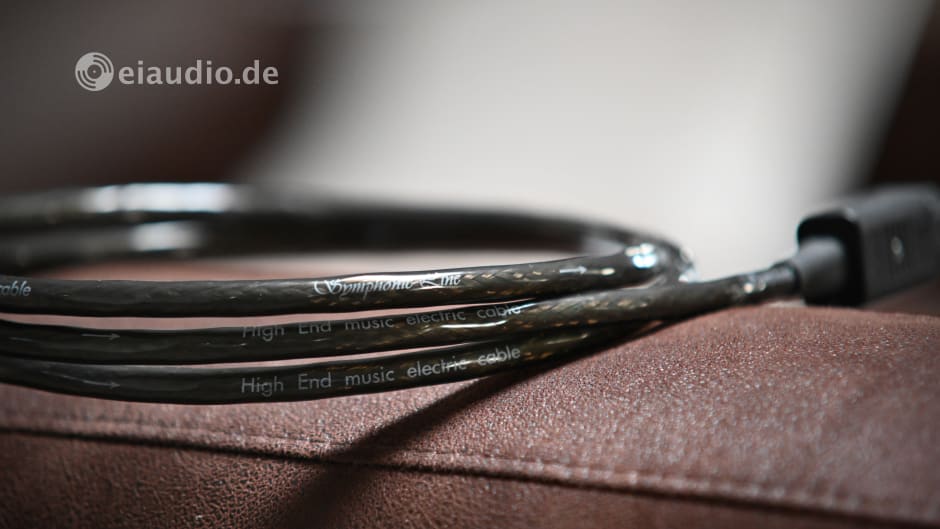
Published: 29/03/2025
Manufacturing date: 2025
Author: Karsten Hein
Category: Gear & Review
Tag(s): Power Cables
If you are a cables-don’t-matter-person and believe that even lamp cord is perfectly suitable for amplifier-to-loudspeaker connections, then this article is not for you. To all those who know how to set up a good HiFi system and have the ears to approve it, the Symphonic Line High End music electric cable is a valuable asset in unleashing the performance of your High End amplifier.
A world of magic.
Join any public HiFi forum today, and you’ll quickly find fiery discussions about audio cables. These conversations often reach a stalemate between those convinced that quality cables significantly impact sound and those who argue that nearly any cable that completes a connection is sufficient. Interestingly, this pattern repeats itself, whether discussing interconnects, speaker cables, or power cords.
While many debates boil down to two questions—'Do cables really matter?' and 'Are High-End cables just snake oil?'—perhaps a more productive approach would be to step beyond personal opinions and anecdotes and to ask: Are forums, where contributors often use pseudonyms and vary greatly in experience, truly the ideal place to explore complex technical issues like cable quality?
Essentially, what cable-effect skeptics do not realise is that they ask us to believe in a magic trick by suggesting that they can change the medium without this having any effect on the crucial properties: capacitance, resistance, inductance, internal resonances, eddy currents, level of signal loss and interference, etc. To the skeptic, a cable will have the same effect on the frequency spectrum and the dynamics of music, regardless of whether it is of an unshielded silver solid-core design or, quite the opposite, a copper-clad aluminium multi-strand with mesh shielding. And this is simply not the case.
The magic of reality.
Back in the real world, the characteristics of cables are so divergent that I have hardly heard two signal cables on a HiFi system that had the same effect on music. Each cable has specific strengths and weaknesses that I accept and have learned to use to my advantage when setting up a system. Since on High End music systems, we normally do not have any attenuators for bass and treble, cable characteristics can be used to darken tonal colours, slow down or increase speed, or to make the HiFi system sound crisper, until the resulting balance sounds just right.
However, despite my personal experience with the importance of signal cables, it did take me some time to accept that this also applied to power cords. Music signals are obviously delicate and span a whole range of frequencies, whereas power cords are directly connected to the house electrical grid (often by means of a power distributor) and only have to handle one specific voltage and frequency (240 volts, 50 Hz for Europe). At first, this seemed like a simple enough job to me that just any cable could do, but, surprisingly, the audible differences between power cords are also quite substantial. Power, after all, is the basis for everything.
How is it possible that power cables contribute to sound?
For one thing, the home electrical installation is made up of solid-core copper wires. These are not certified for movable devices, because solid-core wires are rigid and can easily fracture when bent repeatedly and cause fires. It is for this reason that we change from solid-core to flexible multi-strand wires in a power cord. Doing so causes audible deviations within the electrical current flow. And since this degrading effect is located right before the music-processing device (CD-player, amplifier, etc.), where power integrity should ideally be getting better and not worse, the effect can be considerable.
The power cord is in a crucial position, because it becomes part of the resonance circuit of the respective music device. Its ability to provide clean, resonance free electricity in abundance is essential for the music signal to remain intact. Contrary to popular belief, the ability of a cord to support clean music reproduction does not show in the dimensions of its cable nor in the design of its shiny plugs. Power cords need to be evaluated in their effectiveness when applied in a real-world listening test. And this is precisely where the Symphonic Line High End music electric cable meets its mark.
Built for music.
The authentic reproduction of music signals across the frequency spectrum, with life-like dynamics, correct timing, and natural tonal colors, is a challenge and demands more attention to detail than the power supply of a heating, cooling, or light emitting device. Different rules apply to the design of a power supply and the cord that feeds it, and it takes lots of experience to get the balance just right.
Symphonic Line can look back on a 40-year history of engineering audio devices that satisfy the needs of audiophile High End listeners around the world. The company is owner-operated by its founder, Rolf Gemein, and offers a full range of true-to-source music devices, spanning from CD players, analog drives, integrated amplifiers, pre- and power amplifiers, to loudspeakers and the cables that make each device perform at its best. And as the resulting performance hardly ever hinges on a single device, improving the connections between them has been as important as the devices themselves.
The Symphonic Line High End music electric cable is based on a relatively new concept and was designed to unleash the full performance of High End amplifiers and related audio gear. It is an optical understatement and does not demand much visual attention. It feels light, soft to the touch, and is surprisingly flexible. The cord is moderately priced in the high-end segment, especially when we factor in the sound experience. Its conductors are made up of 2.5 mm2 and 1.5 mm2 multi-litz wires paired with an ultra-fast dielectric with the benefit of low dielectric absorption and fast polarity reversal. The cable uses a filler that is chaotic in structure for higher resonance absorption paired with a soft and transparent outer sheath for better decoupling from the floor.
The quality of workmanship is at the high level that has become the trademark of Symphonic Line products, and the resulting sound is breathtaking. “I wanted to design a cable that would indicate endless clean power reserves to the amplifier under all conditions”, Rolf Gemein said to me, as he was handing me the High End music electric cable for testing at the Norddeutsche HiFi-Tage. “Let me know what you think. And feel free to write about your experience.” On that day, I was taking the Manger P2 loudspeakers to write a review, and the prospect of having a great power cable to choose from presented a welcome opportunity for me.
Since then, I have tested the cable in combination with a Symphonic Line RG10 MK4 Reference amplifier, the Manger P2 bending wave transducers, and my own Martin Logan SL3 electrostatic speakers with a variety of music styles. And I have documented my highly positive experiences in my reviews on the RG10 MK4 Reference amplifier, the Manger P2 loudspeakers, and the WSS Platin Line LS4 speaker cables. All these articles have one thing in common: a power source that is fast and clear of harmful resonances.
Ways to perfection.
I did detect traces of HF interference, however, that the cable did not manage to filter completely, and I therefore decided to add one ferrite bead about 12 cm before the cable enters the amplifier. This immediately freed it from any trace of interference. The RG10 MK4 Reference is a sensitive and powerful amplifier that will take whatever we feed into it and amplify it to well above 50,000 Hz. As we have a large cellphone tower in our neighborhood with visual contact when looking out the window, I have not been able to use any power cable without a ferrite clamp. With cellphone coverage being present in an increasingly tight mesh, this same phenomenon might also apply to your location.
The finished setup allowed for clear and calm sound reproduction. Freed from resonances and HF interference, the RG10 MK4 Reference could realize its full dynamic potential. The music could sound powerful and massive yet delicate and sweet simultaneously, or shift dynamically within milliseconds.
This new potential changed my listening habits and made me favor Broadway musicals simply for the joy of dynamics and the multitude of instruments and voices. Rolf Gemein often talks about the importance of an even power distribution across the entire frequency range, rather than focusing on a single measuring point for better specifications. It is this characteristic that is special in the context of Symphonic Line amplifiers, especially when they are fed from a high quality power source.
With energy effortlessly moving to and from the amplifier, the recording distinguishes itself from the HiFi setup and becomes audible in all its dimensions. There is order on the tonal and dynamic scale at once. Performances take shape, and the body of music can be felt and not only heard in all its dimensions. Marco Kolks (link shows PDF of the German article) wrote about his experience with the High End music electric cable in the German publication “Hörerlebnis”, and I can only agree with his findings and congratulate him on his thoughtful and detailed analysis.
I feel that Rolf Gemein has succeeded at building a cable that provides amplifiers with unbridled clean power, which was his declared mission. If you have the chance to test it on your amplifier, this is certainly an experiment worth your time. Don't judge a book by its cover. The High End music electric cable will easily dwarf cables that look three times more impressive and are much higher priced. Here is one piece of the puzzle on the way to a true High End system.
Specifications
- Type: High End power cord
- Application: High End music sources and amplifiers
- Inner conductors: 2.5 mm² / 1.5 mm²
- Cable length: 160 cm (without plugs)
- Variations: Also available per meter.
- Cable diameter: 9 mm
- Weight: 350 g
- Country of manufacture: Germany
- Year(s): 2022 -
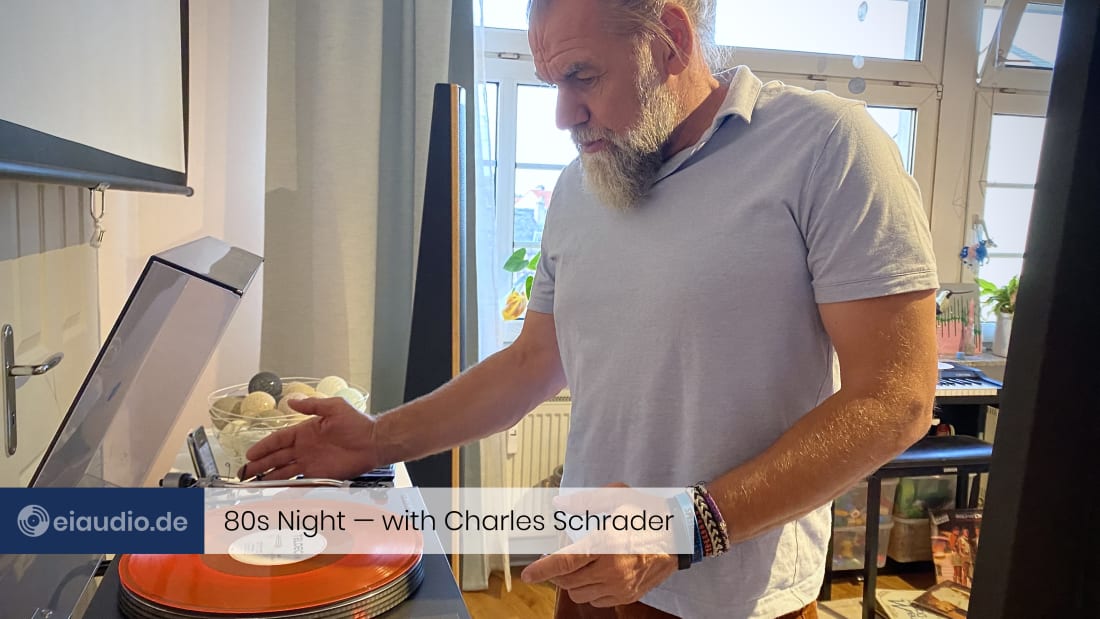
WSS Platin Line LS4
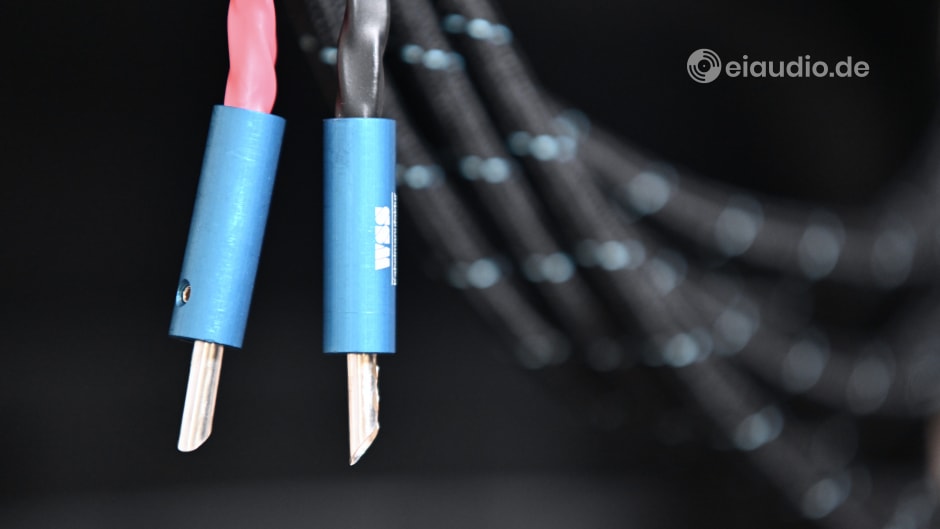
Published: 15/03/2025
Manufacturing date: 2025
Author: Karsten Hein
Category: Gear & Review
Tag(s): Speaker Cables
The WSS-Kabelmanufaktur GmbH & Co. KG run by Jochen Bareiß has been quietly manufacturing affordable High End loudspeaker cables from its home base in Nürtingen since 2002. Each cable is built to WSS specifications and combines highest-quality materials with patented made-for-audio designs. Since its very beginnings, the company has maintained an excellent reputation among audiophiles for its expertise in cable design and down-to-earth product pricing.
A Trusted Standard.
When Daniela Manger entrusted me with a pair of P2 loudspeakers at the Norddeutsche HiFi-Tage trade fair in early February 2025, she mentioned that her speakers performed best when set up in combination with WSS speaker cables. As I still held the company name in good esteem from listening sessions with my former HiFi mentor Luigi di Adamo, I was not surprised by her suggestion and agreed to take this into consideration for my review. The circumstances at the fair, however, prevented me from taking the WSS cables home with me that day. Instead, Daniela asked Jochen Bareiß to send me a pair of his Platin Line LS4 speaker cables by mail.
As, upon my return to our studio in Marne, the WSS cables had not yet arrived, I first set up the Manger P2 using my standard Belden 9497 speaker cables. The amplifier was a Symphonic Line RG10 MK4 Reference in combination with Rolf Gemein’s newly designed Music Cable power cord. My music sources were one trusty Thorens TD320 turntable, featuring an Audiophonics linear power supply and Audio Technica VM95 ML cartridge, as well as a Marantz CD-17 “Ken Ishiwata Signature” CD player wired with Symphonic Line Harmonie HD interconnects. To unleash its audiophile potential, our Thorens was placed on a vibration-cancelling base that was built by Klaus Finnern of Nordic Wood Art for me. Some degree of resonance treatment had also been applied on the Marantz player for a similarly positive effect.
The first listening sessions already revealed a level of sophistication that was highly convincing, with the Manger P2 speakers boasting musical detail and transients that I would rather have expected from our electrostatic Martin Logan SL3 speakers. As I had never heard the Manger P2 perform even remotely at this level while visiting any of the audio shows, I was relieved to see that my review would be a positive one after all. And although Manger’s bending wave driver concept made perfect sense from an acoustic perspective, the fabled transducer did prove to be demanding in terms of front-end integrity and room placement, if it was to show its full potential. In sum, I felt deeply satisfied with the P2’s performance and started to have my doubts whether the WSS cables would have anything more to contribute to this.
First Impressions.
The set of Platin Line LS4 speaker cables came in two simple yet sophisticated suitcase boxes with inner foam lining. One box held the pair of single-wiring speaker cables and the other contained the four cable jumpers for the bi-wiring terminals. All cable ends were terminated with hollow bananas featuring a beryllium/copper base and rhodium-plated surface. The exception was of one of the jumper ends, which featured a spade in order not to get in the way of the speaker cable’s hollow banana plugs. Similar to the Symphonic Line Harmonie HD speaker cables, the WSS Platin Line LS4 use one separate wire strand for the positive and one for the negative connector. On the WSS cables, however, these stands are then joined via shrink tube sleeves at both ends and loosely twisted together for additional shielding effect. The cables look unobtrusive, feel solidly robust, and are well manufactured.
Having connected the LS4 and returned to my listening chair, it did not take me more than five seconds to realise that these speaker cables were indeed special. They had the ability to acoustically step aside and let the music play. The amount of dynamic freedom was more pronounced than on any of the setups I had heard before. While the Belden were superb sounding cables that offered a sense of harmony commonly associated with solid-core designs, speed and agility similar to silver wires, and the musical insights of a low inductance cable, the LS4 did all of this and elevated the experience to a whole new level. For the first time in my audiophile listening explorations, the characteristics of the HiFi system acoustically separated themselves from the recording to set the music free.
I could understand Luigi di Adamo’s long-time fixation with WSS cables and also see why Daniela Manger had nudged me to review her speakers with the LS4 cables. In the end, it was not just one characteristic alone, but a combination of many that made the Platin Line LS4 so potent. Agility and rhythm, tonality and timbre, transients and decay, bass and treble extension: neither of the acoustic properties can fully describe the transformation that happens when the degrading effects of a cable disappear to make its properties invisible to the ear. It was at that moment that I decided to give Jochen Bareiß a call to learn more about the company history and the philosophy behind the LS4 cables. However, as Jochen is quite busy running the WSS Kabelshop, his Hoerenswert-HiFi studio, and visiting trade fairs, I did have to make a few unsuccessful calls, before he eventually called me back and we could have our long talk.
What and Who is WSS?
In this talk, Jochen explained that WSS (the acronym for wire@sound systems) was originally founded by Konrad Wächter in 2002. Wächter was a genuine cable expert who had migrated from the former East Germany to the West in search of better opportunities for his exceptional skills. He was soon hired to run the engineering department for Specialised Cable Applications of a Stuttgart cable works. Wächter later left the company to found his own Kabel Wächter GmbH, a company soon to be known for its innovations in cable designs. When he finally sold the company in 1995, he had many patents to his name and the financial freedom to do what he enjoyed.
As Wächter was not only a cable expert but also an active musician who had studied the bassoon, the idea of manufacturing cables for music applications presented a great opportunity for him to combine his passions in a single project. The Platin Line LS4 is a testament to Wächter’s dedication to music, in that it allows the original signal to reach the loudspeakers without the loss of detail and dynamics associated with broad frequency cable connections. At this time, Jochen Bareiß was running a HiFi studio not too far from Wächter’s new cable company and started to sell them in his shop. He became a regular customer, so that a friendship formed between the two men.
In 2019, Jochen joined WSS to handle the administration of the business, and preparations were made for Konrad Wächter to retire. Jochen Bareiß renamed the company into WSS-Kabelmanufaktur and has been successfully running the shop on his own since 2022. The WSS focus remains on high quality products at affordable prices. The Platin Line constitutes the company’s mid-priced speaker cable segment of which the LS4 is the highest contender. It is made up of seven strands of OFH copper varying in thickness and seven stands of silver-coated copper. As no primer is used in the coating, the silver layer is uncommonly thick and does not bear the risk of acoustic harshness. The wires are stranded in a patented ZS design to reduce cable inductance. The conductor diameter is 2x 4.8 mm² per channel. Teflon is used as dielectric, and a combination of thermoplastic and textile sleeve complete the cable on the outside.
A Real-World Test.
When the P2 speakers were returned to Daniela Manger, I connected my Martin Logan SL3 electrostats to the WSS and was intrigued by the consistency of sound. I completed my article on the Symphonic Line RG10 Reference, and the LS4 played an important role in my assessment to this amplifier. They also led me to reassess the considerable merits of the Martin Logan speakers that had the ability to grow with each improvement. To achieve maximum homogeneity, I had to connect the speaker cables to the bass driver of the Martin Logans and to connect the panels via the jumpers. When connected the wrong way around, the panels acoustically outpaced the dynamic bass driver, causing a slurred impression.
While there are lots of grand theories about speaker and cable design, what ultimately counts is how they appeal to the human ear. In this case we had a friend visit us from Thuringia. Although Katrin is not an audiophile listener by definition, she does enjoy music and is a keen theatre goer. She loves musicals and asked me if she could listen to the Phantom of the Opera on our system. Katrin had seen this musical live in Hamburg and had a CD with some of the songs of it at home. I checked our CD library and found a copy of the full musical. As a kid I had been to the Broadway show and remembered one or two songs that I liked. I remembered the rest of the CD as being rather mediocre and handed Katrin the remote control of the CD player so that she could jump to the track as she liked.
The musical starts with a prelude of almost three minutes, followed by the overture of two minutes, and the first scene of again three minutes. I was sitting on a chair behind Katrin, half expecting her to skip to the next tile and half hoping she would not, because I had never heard the musical in this intensity before. Katrin did not press a button on the remote, until the first CD ended after 19 songs and 60 minutes. She then turned around and looked at me. “So, what do you think?” I asked. “Are you kidding me?” she responded. “This mind-blowingly good and even better than I remember it from the event itself. I could understand every single word, no matter how many people were singing and how many instruments were playing.”
And I knew exactly what she meant, because, until this day, I had not been able to sit through more than three songs of the album. On this system, however, we were both sitting glued to our seats listening for each nuance and following each musical turn the performance took. Music can do that for us, and the WSS Platin Line LS4 are one part of the puzzle.
Specifications
- Type: 2x single-stranded loudspeaker cable
- Application: Single-wiring (with WSS jumpers)
- Termination: beryllium/copper hollow bananas with rhodium-plating
- Design: seven pairs of ZS-stranded wires
- Wire materials: OFH Copper & silver-clad OFH copper
- Manufacturing: silver-coating without primer
- Dielectric: Teflon FEP
- Inner liner: highly flexible thermoplastic
- Outer sleeve: Black textile with thin blue line
- Stranded cross-section: 4.8 mm²
- Cable diameter: 7.8 mm²
- Manufactured in Germany
- Year(s): 2008 -

NDHT Norddeutsche HiFi-Tage 2025
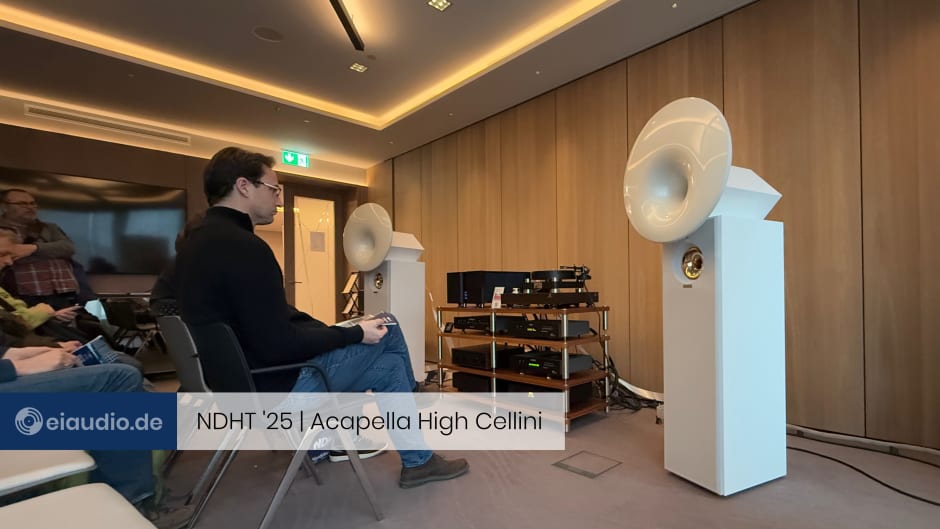
Published: 03/02/2025
Author: Karsten Hein
Category: Explorations
Tag(s): Norddeutsche HiFi-Tage
A Report on Germany's Premier Audio Show
With the HIGH END trade fair relocating to Vienna in 2026, the Norddeutsche HiFi-Tage (NDHT) will become the most significant audio show for the industry in Germany. Each year, hundreds of famous brands in HiFi flock to Hamburg to display their latest product innovations. This year, the fair was hosted by the Le Meridien hotel, located at the Inner Alster, a famous lake in Hamburg's inner city. Below are some key highlights and impressions of my time at the show.
Sieveking Sound (Marten)
The picture shows Jan Sieveking, the founder of the Bremen-based High End retailer by the same name, presenting assorted HiFi gear and audiophile music with heart-felt passion. Because loudspeakers present a clear practical challenge for many home systems—balancing both functionality and the now-infamous Wife Acceptance Factor (W.A.F.)—I decided to keep my focus on them this year. In doing so, I simply assumed that the equipment driving them had been chosen wisely.
As I walked into the room, a pair of Swedish Marten “Parker Quintet” loudspeakers were playing a Leonard Cohen album from vinyl. The setup fit the room well. The music sounded tonally balanced, and the vinyl track revealed a soft and becoming treble. There was natural flow and rhythm to the sound. This, however, changed when we transitioned to a digital source. The treble became overly crisp, and I could not help but focus on the harshness of the tweeters. The rhythm seemed more mechanically driven and the natural flow was replaced by a more fragmented impression. I left the room with the positive memory of the vinyl experience in which the acoustic capabilities of the Martens had managed to shine through. However, the experience again reminded me how fragile the balance can be on modern ultra-precise HiFi setups.
Marten Parker Quintet Specifications
- Type: 2.5-way floor standing speaker
- Frequency range (+/-2dB): 24-40000 Hz
- Power rating (RMS): 350 W (max.)
- Power sensitivity: 93 dB/2.83 V
- Impedance: 4 ohms (2.7 Ohms, min.)
- Crossover frequency: 2200 Hz
- Terminals: Single-wiring, WBT Nextgen
- Internal wiring: Jorma Design
- Cabinet: 35 mm M-board
- Finishes: Piano Walnut, Matte Walnut, Piano Black
- Stands and feet: Stainless steel with Marten Insulators
- Dimensions: (W) 24-33 cm x (H) 117 cm x (D) 54 cm
- Net weight: 60 kg (133 lbs)
Voxativ
The German Voxativ audio company is a designer and producer of High End audio gear based in Berlin. Although the company itself is still relatively young, the company’s co-founder, Dipl. Ing. Inès Adler, has a long history in the industry and is highly knowledgeable about the products she presents. As I walked into the room, I could sense that I was in for an extraordinary experience, not only due to the dazzling personality of the presenter, but also due to the perplexing appearance and sound of the loudspeakers.
The Alberich Array System is a combination of sleek-looking single-driver monitor speakers that are stacked on top of a bass module and held in position by means of a mostly invisible metal rack paired with absorbers. The monitors form an array of three full-range drivers, namely one "Hagen 2" cabinet featuring a Voxativ AF-2B driver (reaching up to 30,000 Hz) sandwiched between two "Hagen 2" cabinets equipped with Voxativ AF-1.9 drivers. An active woofer module takes over below 40 Hz. Powered by a built-in 500W class D amplifier, the sturdy Neodymium PA-Type woofer, which is a dipole (semi-open from both sides), can easily keep up with the speed of the Hagen 2 drivers.
The overall impression created by the Alberich Array System is that of a “Wall of Sound”, as described on the company website. The performance is agile, dynamic, tonally rich, and mostly entertaining and enjoyable. Obviously, some of the merits of a single-driver system are lost in the array setup, and I could not help but wonder what a single Hagen 2 monitor, perhaps paired with the Alberich bass module, would have sounded like. I decided to keep this company in mind for a future visit at the fair (or a trip to Berlin). After all, fresh ideas should be celebrated. Voxativ also offers other lines of speakers, integrated amplifiers, cables, etc.
Voxativ Alberich Array System Specifications
- Frequency response: 20 - 33.000 Hz
- Bass-module: Voxativ AC-ZB
- Monitors Hagen2: Voxativ AF-1.9 and AF-2B
- Power rating (RMS): 50 W
- Power sensitivity: 101 dB
- Dimensions: (W) 20,5 cm x (H) 180 cm x (D) 25 cm
- Colors: Berlin Black, Pure Metal
- Weight: 75 / 150kg
Reichmann Audio (Magnepan)
Reichmann AudioSysteme is a High End audio retailer based in the German Black Forest region and a declared specialist shop for the brands Magnepan, Musical Fidelity, Music Hall, Rekkord and Triangle. Each year, the company brings along a small selection of sophisticated audio gear to caress the ears of the visitors to the fair. While I was a little disappointed by their Musical Fidelity and Triangle setup at the Steigenberger hotel in 2024, this year’s setup and positioning fit the room much better and resulted in a cleaner and faster sound.
This was also the first time that I had a chance to listen to a set of magnetostatic loudspeakers. The Magnepan 2.7i are flat panel speakers using a single magnetic foil to generate all frequencies across the band. Next to electrostatic speakers (such as the American Martin Logan and the Dutch Final) the magneplanar technology promises excellent transient response without phase shifts and lags in response time common to speakers using multiple dynamic drivers.
I was generally pleased with the sound of the setup, although some of the challenges of working with magneto-static speakers also came through. For one thing, the noise floor at a trade fair is relatively high at around 40-50 dB. Magnepan speakers excel in detail retrieval, a strength that is somewhat lost at the fair. Magnepan speakers are most tonally balanced at medium volumes where bass excursion is less pronounced. The volume levels at the fair therefore blurred some of the intrinsic strengths and made the Magnepan seem less dynamic than they would be in a home setup.
Finally, Magnepan speakers produce a relatively narrow sound field which is great when you are having to deal with side wall reflections but not so great when it comes to listening to music well outside the sweet spot. As the Reichmann booth was generally well-attended, I did not manage to sit in the center and therefore mostly heard one channel of the stereo setup. However, this does not mean that I think less highly of them following the experience. Owning a set of Martin Logan electrostatic speakers myself, I do understand that everything is a compromise and still have Maggies on my list of highly attractive speakers to own. Good to know: Magnepan speakers are surprisingly affordable for their performance.
Magnepan 2.7i Specifications
- Type: 3-way, full-range, quasi-ribbon
- Frequency response (+/- 3dB): 40 - 30,000 Hz
- Power requirement: a beefy high-current amp
- Power sensitivity (500 Hz): 86dB
- Impedance: 4 Ohm
- Dimensions: (H)180 cm × (W)56 cm × (D)4.4 cm
- Weight: 21.8–23.6 kg
Auer Acoustics
Located just north of the Chiemsee region in southern Bavaria, Robert Auer manufactures High End speakers “Made in Germany” by master carpenters in his local factory. His passion for wood and quality materials also extends to the trade fair booth, which is fully treated with absorber panels and diffusers along the primary reflection points.
The speakers on display were Versura V_4, large floor-standing models with a narrow front and additional side woofers. I greatly enjoyed the atmosphere and dynamics in the room and also overheard conversations in which the overall sound quality was highly praised. To my own ears, the treble and upper midrange sounded a bit analytical, very similar to the Marten experience described above. It is well possible that the impression was caused by the electronics driving the speakers.
Looking at the impedance curve and sensitivity, the Versura V_4 should be easy to drive, even with a small tube amplifier. And I think this would have been more fun and intimate to listen to than the beefy electronics required for the demonstration at the fair. I therefore made a mental note to listen to them again on the next occasion.
Auer Acoustics Versura V_4 Specifications
- Type: 3.5-way floor-standing speaker
- Power sensitivity: 90 dB
- Power requirements: from 20 WPC
- Nominal impedance: 8 Ohms
- Lower cut-off frequency (+/- 3 dB): 20 Hz
- Upper cut-off frequency (+/- 3 dB): 40 kHz
- Tweeter (Beryllium dome): 34 mm
- Midrange driver: 12 cm
- Bass-to-midrange driver: 18 cm
- Woofer: 32 cm
- Weight: 98 kg
- Dimensions: (H)1.191 m, (W)22 cm, (D)46 cm
- Connections: Bi-Wiring (optional)
Canton
Canton, Europe's largest manufacturer of HiFi and High End audio systems, is based in a small town not too far from Frankfurt am Main. In fact, when my wife Sabina and I took up our HiFi journey once again back in 2012, Canton seemed to offer a fair balance of price and performance. Looking at the photo, it is easy to see why the brand is popular among consumers. Their loudspeaker designs are clean and sophisticated looking, a design that has carefully evolved over the years.
The Reference Series has always been a staple among HiFi enthusiasts. Sadly, however, the setup was such that critical listening was not really possible. On the other hand, visitors had an opportunity to touch and feel the latest designs, to assess speaker sizes and material choices.
Acapella (High Cellini)
Acapella speakers are "from Duisburg of course, the High End capital of Germany", as Richard Rudolph half jokingly explained. I had just stepped out of the Harlekin 2 demonstration, across the hall from Symphonic Line, the other High End Duisburg brand, and was still digesting the experience. Acapella speakers feel solid in every conceivable way, but let's not start here. This section is about the High Cellini.
Horn loudspeakers can sound a little compressed in the midrange, they can be overly large, or have extremely deep cabinets that are difficult to position. Non of these characteristics were present on the High Cellini. From our multiple listening positions, the music sounded detailed, tonally rich, and very dynamic. However, as the listening room was a little too small for the speakers, vocals only began to come together and sound right along the back wall of the room where bass accentuation was becoming a bit of an issue. Such is the nature of the fare, where manufacturers need to make the best of what they are given.
Vocals aside, I was perfectly taken in and could have listened for hours on end when the High Cellini started to play back recordings of wind instruments, such as horns and trumpets. You just don't get the dynamics of wind instruments on more conventional loudspeaker designs. I left the room transfixed, hoping to hear the Cellini in a more suitable room some day soon.
Acapella High Cellini Specifications
- Type: floor-standing horn-loaded loudspeaker
- Frequency range: 25 Hz - 40,000 Hz
- Power sensitivity: 91 dB
- Bass: (2x) 10" driver
- Midrange: (1x) 1" driver hyper-spherical
- Midrange horn diameter: 620mm (wideband)
- Treble: plasma tweeter
- Impedance: 8 Ohm
- Dimensions without horn: (H)1,46 cm x (W)33 cm x (D)47.5 cm
- Dimensions with horn: (H)1.68,5 cm x (W)62 cm x (D)60.5 cm
- Weight: 120 kg
- Power handling: 100 W - 1000 W / 10 ms impulse
PMC
PMC is a British manufacturer of professional studio monitors used in the audio and video industry, as well as a manufacturer of High End audio equipment. The floor-standing Fenestria is their current High-End flagship loudspeaker, measuring 1.70 m and weighing around 80 kg, thereby coming in slightly above the ideal BMI of a human male of this height.
Visually, the Fenestria will appeal to technically minded people and young entrepreneurs who wish to boast of their financial success. But, unless they are driven at high volumes—which they are perfectly capable of—this is not how they sound. Their resonance free design makes them both precise and tonally appealing to the ears. The 2.4 m advanced transmission line design makes their bass performance natural and incredibly extended. The sound remains natural and fluid, even at very high volumes.
PMC Fenestria Specifications
- Type: Floor-standing transmission line speaker
- Frequency Response: 23 Hz – 25,000.
- Power sensitivity: 86 dB
- Impedance: 4 Ohms.
- Crossover Frequencies: 380 Hz and 3.8 kHz.
- Low Frequency: (4x) 6.5-inch, carbon-fibre piston drivers.
- Mid Frequency: 75 mm rear-chambered, soft-dome driver
- High Frequency: 19.5 mm soft-dome, ferrofluid-cooled driver
- Advanced Transmission Line (ATL™): (2x) 2.4-meter
- Dimensions: (H) 1,70 cm; Width: 37 cm; (D): 62.3 cm
- Weight: 80 kg, including plinth.
Ø Audio of Norway
Despite its understated name and design, the FRIGG 02 sounded anything but average to my ears. On the contrary: The modest and clean looking cabinet even supported the no-frills sound philosophy of phase coherence and tonal balance that has become the trademark of Scandinavian HiFi. Surprisingly, the speakers sounded much larger than they looked, which brings us back to the Wife Acceptance Factor.
ø-Audio also builds horn loudspeakers, such as the Icon 12 and the Verdande that I have heard audiophile friends report positively on, although I must confess that I have not yet had a chance to listen to them myself. Another company to keep an eye on, especially because it is currently expanding its international distribution network.
ø Audio FRIGG 02 Specifications
- Construction: 3-way floor-standing speaker
- Power sensitivity: 90db
- Frequency range: 29hz–30khz
- Impedance: 8 Ohms (min 3.8 Ohms)
- Tweeter: TPCD dome with DXT lens
- Midrange: 180mm hand-coated paper cone (titanium former)
- Woofer: 220mm hand-coated paper cone (titanium former)
- Bass reflex: floor-vented
- Dimensions: (H)98,5 cm x (W)21 cm x (D)34 cm
- Width including feet: 37cm
- Weight: 30 kg
Qualio Audio
Qualio from Poland has two loudspeaker models on sale which both combine high quality components from Mundorf, Jantzen Audio, SB Acoustics, WBT, etc. into highly versatile loudspeaker designs. On their website, Qualio explains that the IQ model, for example, uses a semi-closed design featuring an open-baffle treble and midrange section paired with a responsive Satori woofer within a ported cabinet.
The dipole design of the IQ model allows the music to be reflected off the listening room walls, providing a wider sweet spot and a more immersive listening experience. The ported bass cabinet can further be customized to fit small listening spaces by closing the port. From looking at the parts, such as the Mundorf AMT, I can imagine that this speaker has some potential. The music playing during our stay at the booth, however, made it difficult for me to judge its important vocal characteristics.
Qualio Audio IQ Specifications
- Type: Floor-standing, semi-open baffle
- Frequency bandwidth: 30 – 31,000 Hz
- Power efficiency: 89 dB
- Impedance: 4 Ω
- Dimensions: (H)102 cm x (W)38.5 cm x (D)31.5 cm
- Weight: 32 kg
Manger
The company was founded by Josef W. Manger, a German engineer who developed a deep interest in acoustics and how humans perceive sound. His journey into speaker development began during the 1960s. Manger was driven by a desire to create a speaker that could more accurately reproduce sound as it is perceived by the human ear, minimizing distortions and phase issues that are common in traditional driver and loudspeaker designs.
The P2 loudspeaker model makes use of Manger's W06, the latest bending wave transducer of the company. The frequency range of this driver is impressive. Here are the specifications of the driver alone:
Manger W06 Specifications (Driver Only)
- Type: Bending wave transducer
- Frequency response: 150 Hz - 40,000 Hz
- Power sensitivity: 85 dB
- Impedance: 8 Ohms
- Power handling (RMS): 50W,
- Peak power handling: 80W
- Diameter: 15.3 cm
- Mounting depth: 50 mm
- Weight: 1.2 kg
Daniela Manger, the company's CEO in the second generation, is respected within the audio engineering community for her contributions to acoustic design and her commitment to high-fidelity sound reproduction. Her personal efforts have cemented Manger Audio as a distinctive brand in high-end audio, known for its precision, engineering excellence, and steadfast commitment to the unique bending wave technology pioneered by her father.
The first time I heard the P2 loudspeakers perform was at an exhibition at the Auditorium in Münster. The room that the P2 were placed in was less than ideal for them to deliver a satisfactory performance. I spoke to Ms. Manger about my concerns, and she suggested that I could take the speakers home with me following the upcoming Hamburg fair to better understand their sound. This meant, I now had to stay at the Norddeutsche HiFi-Tage fair in Hamburg until its very end in order to take home the speakers with me.
Manger P2 Specifications
- Type: Passive 2-way floor-standing speaker
- Impedance: 8 Ohms
- Frequency range: 30 – 40,000 Hz
- Crossover frequency: 340 Hz
- Power sensitivity: 89 dB
- Sound pressure (max.): 112 dB
- Dimensions: (H)114 cm × (W)27,0 cm × (D)21,4 cm
- Weight: 33 kg
Lyravox
Jens R. Wietschorke (research and development) and Dr. Goetz von Laffert (finance & PR) teamed up in 2013 to challenge established loudspeaker concepts by merging the latest in loudspeaker driver technology and digital signal modulation with fresh compact designs that fully integrate into sleek modern households. Today, Lyravox produces seven loudspeaker models of different sizes to satisfy home entertainment needs.
The Lyravox KARLOS is a floor-standing speaker of modest dimensions that is lifted up and tilted backwards by means of a sturdy metal rack which supports the speaker from underneath and stabilizes it from behind. And although the KARLOS ranks among the company's smaller loudspeakers, it already incorporates most of its signature technology.
The midwoofer of the KARLOS 2-way design uses an ultra-stiff light-weight aluminum cone for superior detail retrieval. This is paired with an Accuton 30mm inverted ceramic dome tweeter that is coupled to a wave guide. Instead of using a passive crossover, the two drivers' transition frequencies are actively harmonized by means of a DSP. The highest frequencies are then added using an up-firing air-motion transformer (AMT). The natural effect of the AMT pointing upwards is a more immersive listening experience and a wider sweet spot.
My first listening expression was that of walking into a cinema while the film was already in progress. The music sounded as large and direct as one would expect from a cinematic experience. There was a sense of purpose and robustness to the sound that initially attracted me. However, the placement of the speakers so close to the floor and in the corners of the room made critical listening difficult. Someone's head was always in the way to cover one of the channels, and the front row seats were in the middle of the room, where bass frequencies tend to cancel out. I therefore made a mental note to give these speakers another listen when they are available in a more appropriate setting.
Lyravox KARLOS Specifications
Design and Drivers
- Configuration: 2-way system with an additional top-firing ambience tweeter.
- Midwoofer: 10-inch (26 cm) aluminum driver by ScanSpeak®, modified for enhanced performance.
- Front tweeter: 30 mm inverted ceramic dome tweeter, custom-designed by Accuton® for Lyravox.
- Ambience tweeter: Top-firing AMT (Air Motion Transformer) L50, enhancing spatial sound characteristics.
Amplification and Processing
- Amplifiers: Each speaker houses two Class D amplifiers (4th generation NCore®), delivering a total of 500 W per speaker.
- Digital Signal Processing (DSP): High-resolution DSP for precise crossover management, time alignment, and room equalization.
Inputs and Connectivity
- Analog Inputs: Balanced XLR and unbalanced RCA.
- Digital Inputs: AES/EBU (XLR), S/PDIF (coaxial RCA), and optical (Toslink).
- User Interface: Solid aluminum infrared remote control for standby, mute, volume, source selection, and sound presets.
Physical Specifications
- Dimensions: (W)40 cm x (H)70 cm x (D)18.5 cm; with stand: (W)40 cm x (H)87.5 cm x (D)37 cm
- Weight: Approximately 22 kg per speaker.
- Finish: Standard finish in Brilliant Interior White with an ultra-smooth matte coating (NCS-S 0500N). Custom colors and finishes are available upon request.
Additional Features
- Room Adaptation EQ: Integrated parametric equalizer for room-specific acoustic adjustments, ensuring optimal sound performance in various environments.
- Active/Digital Multi-Channel Amplification: Direct amplification of speaker drivers eliminates distortions and phase shifts associated with traditional passive crossovers.
- Optimized Cabinetry: Constructed from high-density fiberboard (HDF) with internal bracing and multi-component damping to minimize resonances.
The KARLOS is designed for rooms ranging from 20 to 50 square meters, offering a frequency response from 28 Hz to 28,000 Hz, depending on room acoustics. Its combination of advanced driver technology, sophisticated amplification, and meticulous cabinet design ensures a compelling and immersive listening experience.
EMT 928 (2022)
The EMT 928 is a revival of an industry classic. The original EMT 928 was a professional turntable that was introduced in 1971 by Elektromesstechnik Wilhelm H. Franz K.G. (EMT) in Germany. It was unique in EMT's lineup as their only belt-driven model and developed in collaboration with Thorens. It was actually based on the Thorens TD125. Designed for studio use, the EMT 928 featured a compact and lightweight design, making it suitable for mobile broadcasting applications.
In 2022, EMT introduced the EMT 928 II, a modern reinterpretation of the original. This updated model retains the belt-drive system—as a homage to its predecessor—but incorporates some contemporary enhancements: Notably, it features an independent battery power source, providing over 40 hours of playback while eliminating potential interference from the mains supply. The chassis is precision-machined from aluminum and rests on four decoupled, spherical feet. The 5.5 kg platter is driven by a modern 20-watt motor combined with a high-precision control loop circuit, ensuring rapid acceleration and consistent speed within tight tolerances.
I did not get a chance to listen to the turntable perform at the fair, but I was immediately taken in by its sleek design, especially when stacked on top the phono preamplifier with the same basic chassis form. What a crazy world this will be when these new High End icons will be available on the used market. That will surely be much more interesting than the devices available to budget shoppers today.
EMT 928 II Specifications
- Platter speeds: 33⅓, 45, and 78 RPM
- Wow and flutter: ±0.07% (IEC 386)
- Rumble: -85 dB (IEC 98)
- Speed-up time: 10, 12, or 20 seconds, depending on the speed
- Battery duration: 30-40 hours
- Dimensions: (W)48 cm x (D)34 cm x (H)10 cm
- Weight: 23 kg
- Output terminal: RCA, with a separate tonearm ground
- Tonearm compatibility: Prepared for EMT 9-inch
- Tonearm mounting distance: 215-245 mm
Acapella (Harlekin 2)
Solid and sophisticated are two adjectives that come to mind when I think of my listening experience with the Harlekin 2 at this fair. Capable of recreating life-like music events between your ears at any moment and volume you may desire. Acapella speakers are a rock in the ocean when it comes to a sober presentation in the midst of chaos around them, a characteristic that had me nailed to the seat for the longest time. How do they do it?
Part of it may have to do with the driver technology, with the company's experience of creating uncolored horn speakers. Perhaps it is resonance management that is at play here. Perhaps it is their origin in Duisburg, as Richard Rudolph suggested. Whatever it may be, the Harlekin 2 are surprisingly effective at making music come alive and—all considered—the speakers that I would have taken home with me, if purchasing speakers had been my mission on that day.
Acapella Harlekin 2 Specifications
- Type: 2-way vented floor-standing speaker
- Frequency Response: 20 Hz – 20,000 Hz
- Mid-woofer: 1 x 254 mm (10")
- Tweeter:1 x 43 mm (1.7") dome with hyper-spherical horn
- Crossover frequency: 2 kHz
- Sensitivity: 91 dB / 1 W / 1 m
- Impedance: 8 Ohms
- Dimensions : (H)120.5 cm x (W)29.5 cm x (D)46 cm
- Weight: Approximately 75 kg (each)
FINAL AUDIO
As I entered this particular room, I was accompanied by four gentlemen who had never heard an electrostatic speaker perform before. They walked around the tall speaker panels in disbelief and said that they very much enjoyed the sound they heard. And, personally, I had never heard the sound of a non-hybrid electrostatic speaker before. My Martin Logan speakers use a conventional dynamic woofer in a closed cabinet to kick in at the lower frequency spectrum.
I also enjoyed the sound of the FINAL 15+ speakers and was surprised how well they managed to present bass frequencies despite their obvious constraint in physical movement. They sounded agile, crisp, and punchy. What I did miss, however, was the wider scope of the Martin Logans which have a curved front panel. In this sense, the music propagated from the FINAL 15+ much like it did from the Maggies above. This is not a killer argument per se, and listening tastes do vary, but it is a difference one might want to be aware of.
FINAL AUDIO Model 15 Specifications
- Frequency Response (±3 dB): 45 Hz – 23,000 Hz
- Horizontal Dispersion: 20°
- Sensitivity: 88 dB
- Impedance: 4 ohms; 3 ohms at 20,000 Hz Dimensions:
- Panel: (H)203 cm x (W)36.6 cm, bottom / 30 cm, top
- Footplate: (L)40 cm x (W)42.9 cm
- Weight: 18 kg (each)
- Transducer: Super linear electrostatic transducer
- Recommended power: 30 to 200 WPC
- Components: Custom-made C core transformer
- Inputs: Custom 2-way binding posts
Symphonic Line
Walk into room 202 and meet the grand master of High End audio himself. Because much of what we classify as High End today has its roots with Rolf Gemein and the other founders of the High End Society. Here are the origins of the famous High End trade fair and also the origins of the Norddeutsche HiFi-Tage. Mr. Gemein recalls the Society's founding moment as an archetypal event, driven by a spirit and energy that made it clear to everyone involved that they were onto something great.
With two unpretentious-looking Symphonic Line "RG5 Reference" speakers positioned down the long left wall of the room and Rolf Gemein sitting in the opposite right corner, room 202 radiates acoustic warmth and looks inviting. The amplifier driving the speakers is a Symphonic Line "Kraftwerk MK3" that receives its signals from a Symphonic Line "La Musica MK3" CD Player. All components from the electric socket to the speakers are made by the same company and have been checked and confirmed by the man himself.
The seasoned founder of Symphonic Line selects outstanding recordings from the 1950s until today and in his calm voice explains the special moments captured by each one. The twelve seats in the room are mostly occupied during the day, and visitors often need to wait their turn before they can be seated. Looking around, I see that many visitors have their eyes closed while they are enjoying the music. I hope that none of them fall asleep and thereby unnecessarily extend the waiting time for everyone else. Music and the anecdotes around it are the focus of attention here, because the system only demands attention in those brief moments in which it thunders an unexpected attack into the room.
Görlich chassis will do this for you anytime. In combination with the air motion transformer "Belcanto MK2" they make music feel so natural and effortless that one can easily forget the speakers. Vocals are smack center stage and the instruments perfectly positioned around them, until—slam—you get a surprising salve of a drum beat that simply stuck out from the rest. Eyes open for a moment, people looking around for confirmation "Did you hear this, too?". I left the room feeling satisfied, relinquishing my seat to the next listener waiting in the corridor.
WESTLYD
A refreshingly fundamental Rock and Pop speaker design that is capable of playing loud with ease. The resulting sound signature is an interesting blend of the 1980s and our modern tastes. The sound quality, especially in the vocal spectrum and on quieter music played, is not on par with Tannoy and other more established brands, but it really does not have to be at the current price point.
Let's explore together

Get in touch with me
If you happen to live within reach of 25709 Marne in northern Germany and own vintage Hi-Fi Stereo classics waiting to be explored and written about, I would be honoured to hear from you!
Your contact details
All reviews are free of charge, and your personal data will strictly be used to organise the reviewing process with you. Your gear will be returned to you within two weeks, and you are most welcome to take part in the listening process. Gear owners can choose to remain anonymous or be mentioned in the review as they wish.
Thank you for supporting the eiaudio project.
Audiophile greetings,
Karsten


